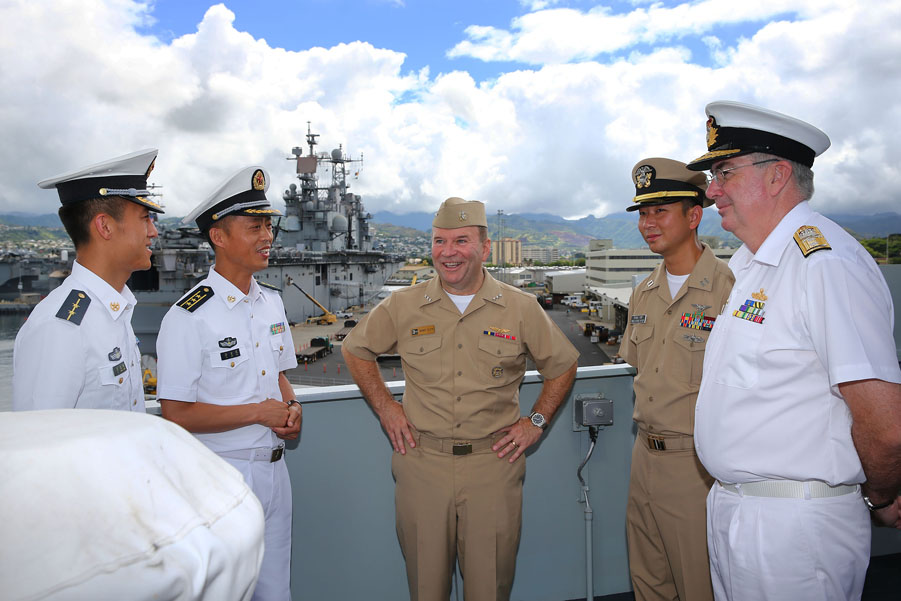US admiral tours Chinese warship
Updated: 2014-06-30 01:25
By ZHANG SHAOHU in Honolulu and CHEN WEIHUA in Washington(China Daily USA)
During the world's largest maritime security drill, Chinese and US naval officers taking part in the Rim of the Pacific exercise (RIMPAC) expressed hopes for further military-to-military cooperation in the future.
Zhao Xiaogang, drill director of the participating Chinese fleet, said the Chinese People's Liberation Army Navy (PLAN) would like to continue to participate in the RIMPAC in the future.
He made the remarks to US Vice-Admiral Kenneth Floyd, commander of the US Third Fleet who serves as this year's RIMPAC Combined Task Force Commander, during Floyd's visit to the Chinese four-vessel fleet on Saturday morning.
Floyd said the US side would also like to continue to invite PLAN to participate in the drills and to have a broader and deeper participation in RIMPAC.
At 9:30 am on Saturday, Floyd and his entourage boarded the Chinese missile destroyer Haikou, the command ship of the Chinese participating fleet, at Pier K7 in Pearl Harbor. Accompanied by Zhao, the visitors toured the bridge and front deck of the ship. They met in the conference room and exchanged gifts, their ship caps.
Zhao told Floyd that the Chinese fleet participating in 2014 RIMPAC had a smooth sail to Hawaii from Guam where it joined the USS Chosin and USS Howard and other multinational forces.
The training activities held during the voyage laid a solid foundation for the formal drill, while officers and sailors from different nations conducted very pleasant exchanges to boost their mutual understanding, Zhao told Floyd.
Floyd agreed. He and his entourage then toured the hospital ship Peace Ark, supply ship Qiandaohu and missile frigate Yueyang and discussed respectively with captains of Yueyang and Qiandaohu about the training of PLAN captains and the special design features of the Chinese supply ship.
The Chinese fleet arrived in Pearl Harbor on June 24 as part of a convoy of nine ships from four nations. The other three nations were the US, Singapore and Brunei.
"During our transit from the Guam Operating Area to Pearl Harbor, we refined our interoperability and strengthened our partnerships with a number of exercises involving personnel exchanges, weapons firing, ship-handling and maneuvering drills and communications exercises," said Patrick Kelly, commanding officer of the guided-missile cruiser USS Chosin who led the convoy.
Bonnie Glaser, senior advisor for Asia at the Center for Strategic and International Studies in Washington, said China's participation in RIMPAC is substantial and significant.
"The process of planning for and executing these drills has been a good confidence building exercise for the US and Chinese navies," she said.
Glaser believes that China is likely to participate again and in more drills in the next RIMPAC to be held two years from now.
"But I expect that participation will be confined to non-traditional security areas. War-fighting drills will be off limits as that would violate the 2000 NDAA," she said, referring to the 2000 National Defense Authorization Act passed by Congress which forbids many military exchanges with China. China has repeatedly expressed its frustration with NDAA, describing it and several other US legislations as obstacles to improving bilateral military-to-military exchanges and cooperation in a bid to boost much-needed mutual understanding, strategic trust and reduce the risk of miscalculation.
Both Chinese President Xi Jinping and US President Barack Obama agreed to push for more high-level military exchanges and cooperation when they met in 2013 in Sunnylands, California.
Besides the visit by the RIMPAC commander Floyd, the Chinese hospital ship Peace Ark also hosted on Saturday morning nine RIMPAC medical staff members led by Timothy Hinman, chief medical officer of the US Third Fleet.
Hinman praised the advanced equipment on the Peace Ark and also the friendliness of the sailors. "You should feel proud for having such a wonderful hospital ship," he told his Chinese host.
The visitors watched a documentary about the humanitarian assistance missions carried out Peace Ark.
In September 2010, Peace Ark set sail on a three month mission to the Gulf of Aden with a total of 428 officers, including 100 medical workers. During the trip, it provided medical treatment to people in Djibouti, Tanzania, Kenya, the Seychelles and Bangladesh.
Last November, the hospital ship was deployed to Tacloban, the Philippines, to assist in the recovery from typhoon Haiyan, despite the fact that tension was still high between China and the Philippines over maritime territorial disputes in the South China Sea.
The RIMPAC visitors on Saturday included medical staff of the US Navy hospital ship Mercy and Royal Canadian Navy.
Accompanied by Sun Tao, head of Peace Ark's hospital, the visitors toured several demonstration areas of the ship, including one on Traditional Chinese Medicine. One Canadian medical doctor, who said he had experienced Chinese acupuncture and massage, tried the Chinese suction cup therapy on Peace Ark.
It is the first time for hospital ships to participate in RIMPAC since the drills first began in 1971. Peace Ark and Mercy will hold more exchanges and operations in the coming days.
RIMPAC 2014, the 24th in its history, has drawn the participation of 22 nations with 47 ships, six submarines, more than 200 aircraft and 25,000 personnel in and around the Hawaiian Islands. It ends on August 1.
Contact the writers at zhangshaohu@chinadaily.com.cn and chenweihua@chinadailyusa.com.
